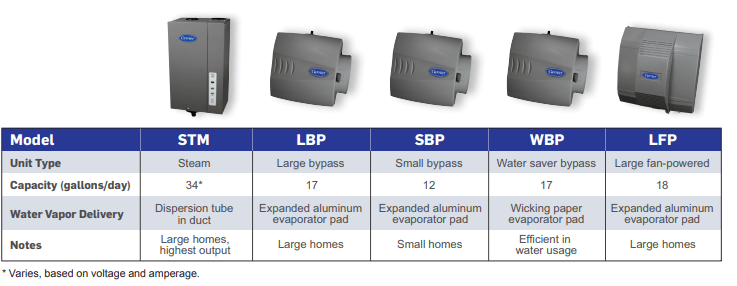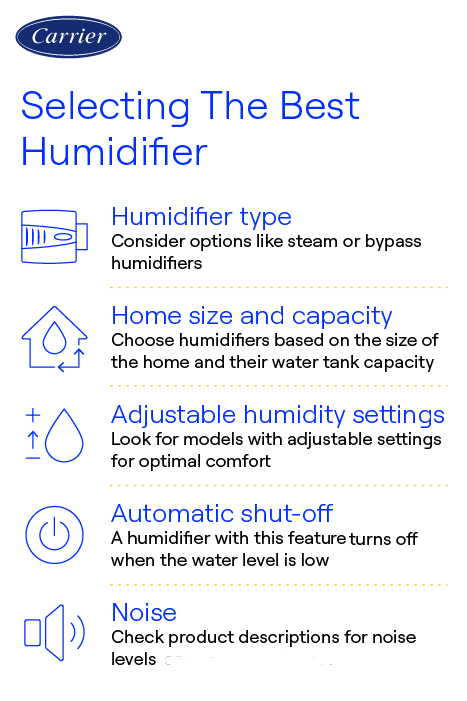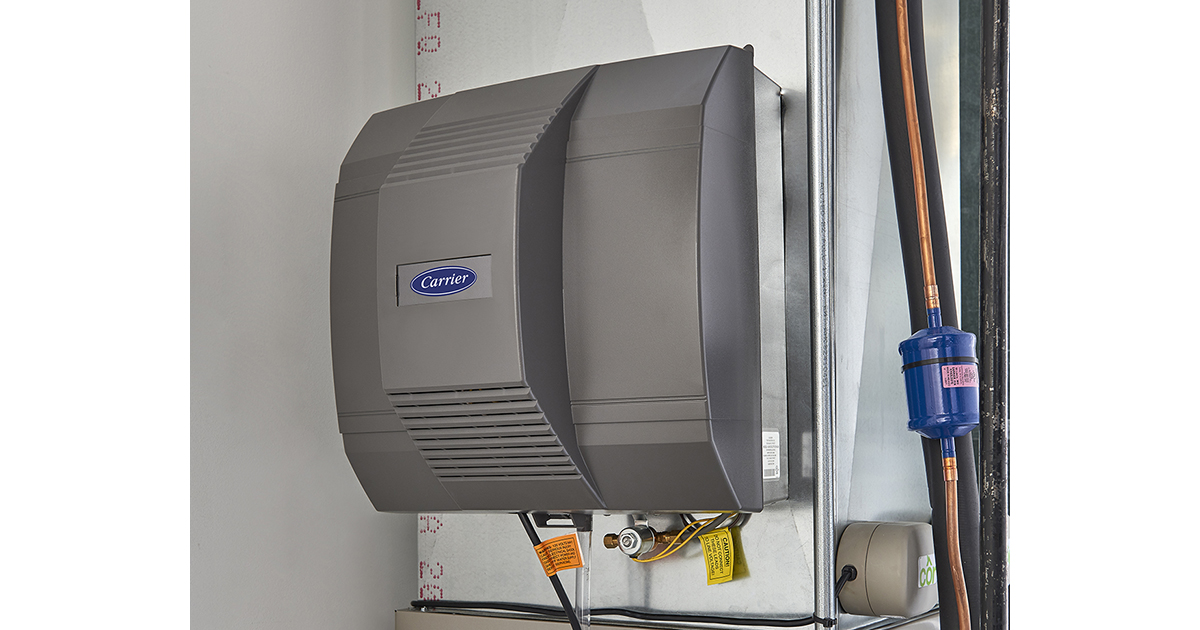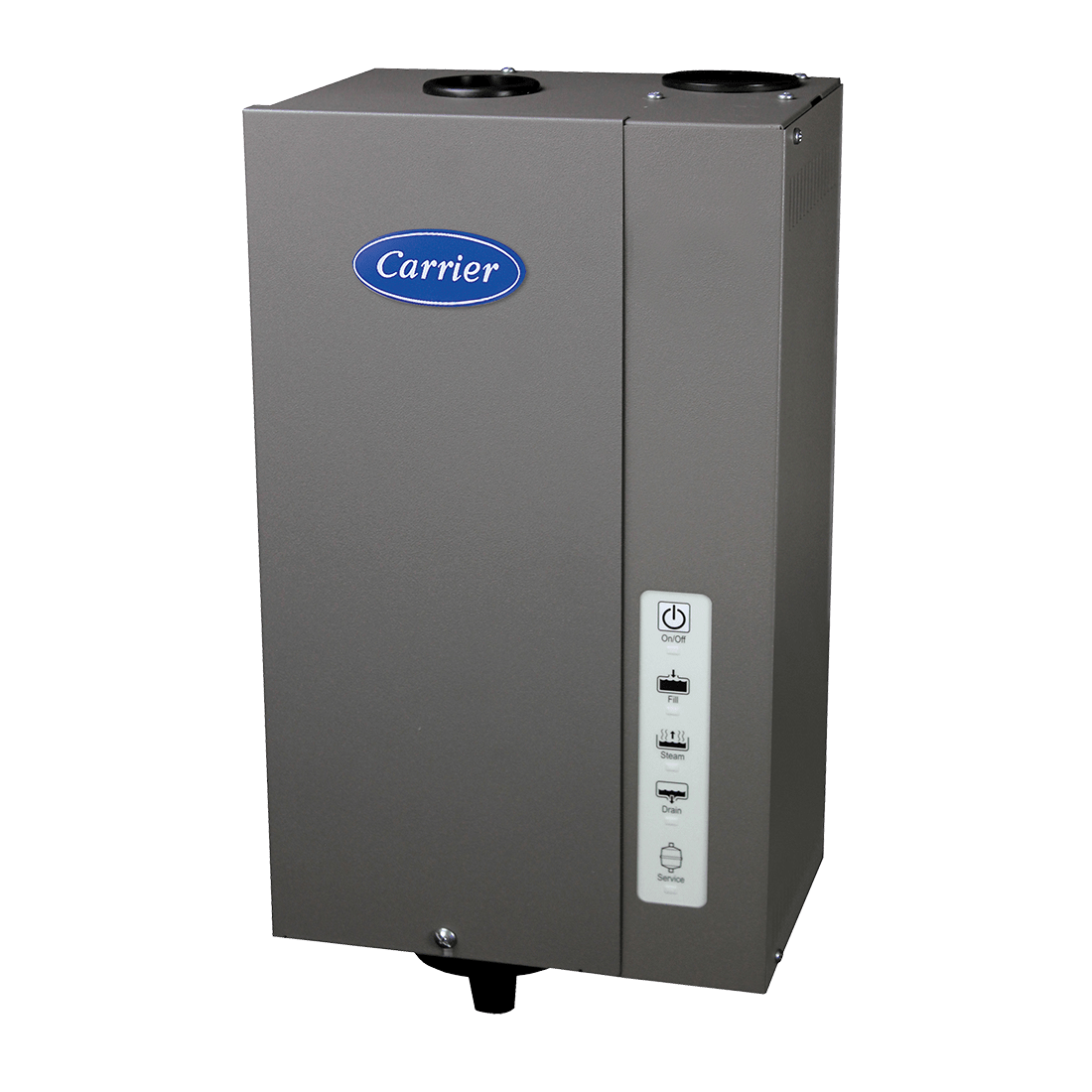Choosing the Best Humidifier For Your Home
By Travis Baugh
Do you find yourself asking the question “What is the best humidifier for my home?” Understanding the different types of humidifiers is the first step in making an informed decision on choosing the right humidifier for your home this winter. Carrier offers many types of humidifiers: steam humidifiers, fan-powered humidifiers, and bypass humidifiers.

Steam Humidifiers
A steam humidifier is a type of humidifier that adds moisture to the air by boiling water to produce steam, which is then released into the air. These humidifiers are often used in homes to maintain optimal humidity levels, particularly in places where the climate is dry or during winter when heating systems can lower indoor humidity. Most steam humidifiers come with humidity sensors that allow for precise control of humidity levels in the space. Steam humidifiers can provide a consistent level of humidity, regardless of the temperature, because they do not rely on evaporation like some other types of humidifiers. Steam humidifiers can be stand-alone units or integrated into HVAC systems to maintain desired humidity levels throughout a space.
Fan-Powered Humidifiers
A fan-powered humidifier is a type of humidifier that uses a built-in fan to help distribute moisture into the air. Unlike passive humidifiers that rely on the natural flow of air from a furnace or air handler, fan-powered models actively blow air across a moistened pad or evaporator, allowing them to add more humidity to the space more quickly. The humidifier is connected to a water source, which keeps a water panel or evaporator pad moist. The fan draws warm air from the HVAC system or room and pushes it across the water-saturated pad. As the air passes through, it picks up moisture from the pad, and the humidified air is then released into the ductwork or directly into the room. A humidistat is usually included to regulate the humidity level, automatically turning the humidifier on or off to maintain the desired moisture level. The fan helps distribute moisture more effectively compared to bypass humidifiers, which rely on the system’s airflow. These humidifiers typically have a higher output capacity, making them suitable for larger homes or spaces. They can be installed as part of a home’s central HVAC system (ducted) or as a stand-alone unit in a specific room.Bypass Humidifiers
Bypass humidifiers use less electricity in comparison to fan-powered solutions and are ideal for smaller and medium sized homes. A bypass humidifier is a type of whole-house humidifier that relies on the airflow from the HVAC system to distribute moisture into the air. It does not have a built-in fan like fan-powered humidifiers; instead, it uses the pressure difference created by the HVAC system to push air through a water-soaked evaporator pad or water panel, adding moisture to the air before it is circulated throughout the home. The humidifier is connected to a water line, which keeps the water panel or evaporator pad moist. The unit is connected to the HVAC system using a bypass duct, which routes warm air from the supply duct through the humidifier. As the warm air passes over the water-soaked pad, it picks up moisture and returns through the return duct back into the furnace or air handler. A humidistat controls the operation of the humidifier, turning it on or off to maintain a set humidity level.

Selecting The Best Humidifier

In addition to humidifier type, another important consideration is the room size and capacity. Humidifiers come in various capacity levels reported in gallons per day, and it's essential to choose one that can effectively distribute enough water to humidify the desired space. Too small of a humidifier may not provide enough moisture or cause the humidifier to run constantly, while too large of a unit may lead to excessive humidity levels. A humidifier that includes a control that monitors the humidity adjusts as needed is best.
When selecting a humidifier, there are certain features to look for that can enhance its performance. Some key features include adjustable humidity settings, automatic shut-off when the desired humidity level is reached, easy-to-clean design, and quiet operation.
“When choosing the best humidifier for your home, it is important to know the furnace style, ductwork requirements and limitations, and your home’s needs,” Kevin Dickson, president of Energy Services Air Conditioning, Heating and Electrical in Naperville, Illinois, said. “Just as important is the control that you will be using to operate the humidifier.”

Proper Maintenance and Care for Your Humidifier
Once you have your humidifier installed, Carrier recommends simple, routine humidifier maintenance with a qualified HVAC contractor to achieve maximum results. Many humidifier models allow maintenance operations to be completed without tools, quickly and conveniently, so you can keep your system operating at its best.
Cleaning and disinfecting your humidifier on a regular basis is crucial. Over time, mineral deposits, mold, and bacteria can accumulate in the water tank, which can affect the quality of the mist emitted.
Replacing evaporative humidifier pads is another important aspect of humidifier maintenance. Depending on the type of humidifier you have, you may have an evaporative pad that needs regular replacement or maintenance. These components help trap minerals and impurities from the water, preventing them from being released into the air. Check your humidifier's user manual for specific instructions on when and how to replace these components.
Humidifier Settings
Monitoring humidity levels and adjusting humidifier settings is vital to ensure your humidifier is providing the right amount of moisture. Too little humidity can lead to dry skin, irritated sinuses, and static electricity, while excessive humidity can create an environment conducive to mold and mildew growth. Invest in a hygrometer to measure the humidity levels in your home. Adjust your humidifier's settings accordingly to maintain a comfortable and healthy indoor environment.
Tips for Optimal Humidity in Your Home
Maintaining the right humidity level in your home is essential for both comfort and health. To help create a healthy and comfortable environment, here are some tips for achieving optimal humidity levels in your home.
-
Ideal humidity levels:
For most households, a humidity range between 30% and 60% is considered ideal. This range provides enough moisture to prevent dryness, without creating excessive condensation or promoting the growth of mold. Using a humidifier can help achieve and maintain this optimal humidity level.
-
Avoiding excessive moisture and condensation:
While it's important to maintain a certain level of humidity, excessive moisture can lead to condensation on windows, walls, and other surfaces. To prevent this, make sure your home is well-insulated and properly ventilated. Use exhaust fans in kitchens and bathrooms to remove excess moisture, and repair any leaks or water damage promptly.
Consult Your Local Carrier Dealer On The Best Home Humidifier For You

Frequently Asked Questions For Choosing The Best Humidifier
Explore Carrier Whole Home Humidifiers
Consider a Carrier whole home humidifier to maintain ideal humidity levels and enhance comfort in your home. Carrier whole home humidifiers help prevent dry skin, static electricity, and respiratory issues by adding moisture to the air, especially in the winter months. They are designed for quiet operation and energy efficiency, ensuring consistent humidity control without increasing energy costs. With reliable performance and easy integration into your HVAC system, Carrier whole humidifiers promote a healthier, more comfortable living environment year-round.
Learn More About Whole Home Humidifiers
- Learn about the cost to buy or replace a whole-home humidifier
- Discover humidifier benefits
- What are whole-home humidifiers & how do they work?
- Furnaces and humidifiers: how they work together
- Learn the difference between a humidifier vs dehumidifier
- Discover what humidity should be house be at?




